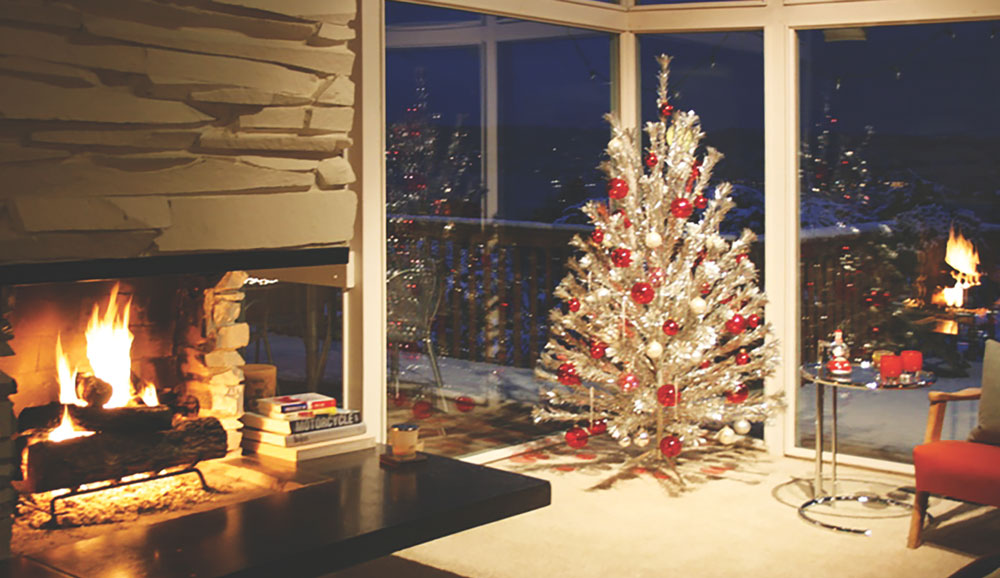Yuletide Cool
Writer Ren MillerAluminum Christmas trees offer nostalgic charm

Some aluminum Christmas trees were made with curled needles resembling pom-poms on the end of each branch. | Photo courtesy of Michelleration
With the dawn of the Space Age in 1957, political, technological and cultural horizons started to expand like never before. A new focus on modern shapes, styles and materials influenced everything from spaceships to home décor — even Christmas décor, including silvery trees that almost looked like space rockets themselves.
Alternative Christmas trees have a long history — bare branches wrapped in snow-white cotton in the early 1800s, trees fashioned from green-dyed goose feathers in the late 1800s, silver-sprayed trees in the early 1900s. However, the first practical silvery tree debuted just a few months after the first launch of an artificial satellite. In time for Christmas 1957, Modern Coating Co. of Chicago introduced “Angel Pine,” a tree featuring branches with aluminum “needles” secured to a central wooden post. The tree was designed with a futuristic aesthetic in mind and was targeted at the luxury market with price tags of $80 to $120 between 1957 and 1959 (the equivalent of $755 to $1,130 today).
The trees captured the imagination of the Space Age generation, but they were expensive, bulky and difficult to assemble. That opened the door for another company, Aluminum Specialty Co. in Manitowoc, Wisconsin, to design a similar tree more suited to the mass market. ASC received a license to produce a lighter-weight, less-expensive tree under the Evergleam name. The Evergleam trees, introduced in 1959, were easy to assemble thanks to predrilled holes in the trunk and aluminum branches with woven aluminum foil needles. With a price tag of $5 to $25, depending on size (the equivalent of $47 to $235 today), they also were more affordable than the Modern Coating Co. trees.
Lighting remained a challenge. Stringing electric lights on a metal tree could short-circuit electrical systems. Instead, lighting companies introduced electric color wheels comprising a spotlight under a rotating wheel of translucent red, green, blue and yellow plastic. The fixture sat on the floor and shot colors up through the tree as the wheel turned. As if that didn’t create enough of a kaleidoscope, rotating tree bases were sold to multiply the effect.
The color didn’t stop there — before long the aluminum trees were available in pink, gold, blue, green, teal and flocked, in addition to silver. Some people left their trees undecorated; others hung balls of one or two colors (blue and red were popular, alone or with white) or colorful small glass ornaments by companies such as Shiny-Brite, which for a time had factories in Hoboken, Irvington, North Bergen and West New York in addition to its main plant in Pennsylvania.
Within the next half decade, ASC and competitors were selling more than a million trees per year. But then cartoon character Charlie Brown stepped in and put a stop to it — or so the story goes.
The landmark 1965 television special “A Charlie Brown Christmas” tells the story of kids preparing a holiday play. They want a tree to set the stage, but Lucy Van Pelt doesn’t want a mundane Christmas tree. Instead, she implores Charlie Brown to get a “big, shiny aluminum tree … Get the biggest aluminum tree you can find, Charlie Brown,” she says. “Maybe painted pink!”
Lucy’s request horrifies Charlie Brown, who was already lamenting the commercialization of Christmas and who eventually opts for a natural green tree, a scrawny specimen that turns into a beauty once decorated. The show’s dim view of commercialization was fed by steady growth in discretionary income and a growing number of televisions in homes, which dramatically increased the arena for ads suggesting how to spend that income.
Just as they had for Charlie Brown, the glistening branches of aluminum Christmas trees started to lose their luster for real consumers. Secondary factors: the Space Age was no longer new; decor trends were shifting from the simple, sleek look of Midcentury Modern toward the earthy colors and distressed finishes of Tuscan and French country style; the first Earth Day in 1970 directed attention to natural materials; and people who preferred the low maintenance and reusability of faux trees could now choose the (slightly) more natural look of trees with green plastic needles that could accommodate electric lights. By the early 1970s, aluminum trees were virtually nonexistent on the market, and existing ones were either tossed in the trash or stowed in attics and basements.
With a renewed interest in Midcentury Modern design in the 2000s, people began to look for symbols of a clean-lined aesthetic, including more open floor plans, vintage and reproduction Midcentury furniture, and, yes, aluminum Christmas trees. “A growing cadre of collectors, enthusiasts of Midcentury Modern design and those who appreciate the long lifespan and low maintenance of [aluminum Christmas trees] view the sparkly metal totems as legitimate objets d’art, and vintage trees now routinely sell for hundreds — rare ones for thousands — of dollars,” Kris Manty says in a December 2020 article in “Antique Trader,” a magazine and newsletter covering the antiques market. “With many baby boomers fondly recalling the aluminum-gilded holidays of their youth, the metal trees also symbolize comforting nostalgia.”
Vintage aluminum trees now sell mostly in secondary markets and online. Though most cost $350-$700, depending on size and condition, prices can skyrocket for rare colors or trees in original packaging. In late September, for example, a 7-foot gold aluminum tree made by Star Brand Co. in the 1950s was offered on eBay for $3,500; a 4-foot silver aluminum tree made by Modern Coating Co. in 1959, unused and in its original box, was listed on 1st Dibs for $3,400.
There’s even a museum: the Aluminum Christmas Tree Museum (officiallyknown as the Aluminum Tree & Aesthetically Challenged Seasonal Ornament Museum and Research Center) is part of the Transylvania Heritage Museum in Brevard, North Carolina (TransylvaniaHeritage.org).
